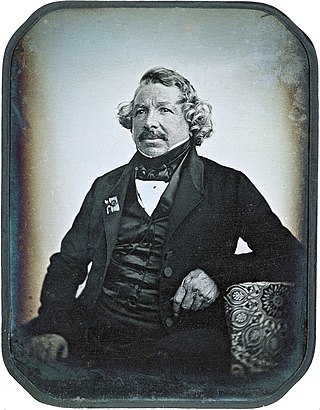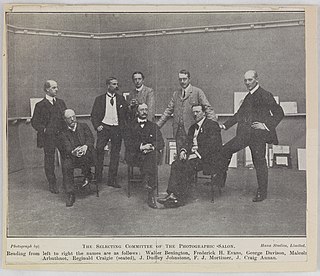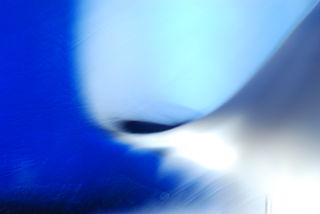Related Research Articles

Photography is the art, application, and practice of creating images by recording light, either electronically by means of an image sensor, or chemically by means of a light-sensitive material such as photographic film. It is employed in many fields of science, manufacturing, and business, as well as its more direct uses for art, film and video production, recreational purposes, hobby, and mass communication. A person who makes photographs is called a photographer.

Calotype or talbotype is an early photographic process introduced in 1841 by William Henry Fox Talbot, using paper coated with silver iodide. Paper texture effects in calotype photography limit the ability of this early process to record low contrast details and textures.

Daguerreotype was the first publicly available photographic process, widely used during the 1840s and 1850s. "Daguerreotype" also refers to an image created through this process.

Pictorialism is an international style and aesthetic movement that dominated photography during the later 19th and early 20th centuries. There is no standard definition of the term, but in general it refers to a style in which the photographer has somehow manipulated what would otherwise be a straightforward photograph as a means of creating an image rather than simply recording it. Typically, a pictorial photograph appears to lack a sharp focus, is printed in one or more colors other than black-and-white and may have visible brush strokes or other manipulation of the surface. For the pictorialist, a photograph, like a painting, drawing or engraving, was a way of projecting an emotional intent into the viewer's realm of imagination.

Louis-Jacques-Mandé Daguerre was a French artist and photographer, recognized for his invention of the eponymous daguerreotype process of photography. He became known as one of the fathers of photography. Though he is most famous for his contributions to photography, he was also an accomplished painter, scenic designer, and a developer of the diorama theatre.
Panoramic photography is a technique of photography, using specialized equipment or software, that captures images with horizontally elongated fields of view. It is sometimes known as wide format photography. The term has also been applied to a photograph that is cropped to a relatively wide aspect ratio, like the familiar letterbox format in wide-screen video.

Color photography is photography that uses media capable of capturing and reproducing colors. By contrast, black-and-white or gray-monochrome photography records only a single channel of luminance (brightness) and uses media capable only of showing shades of gray.
Steven Pippin is an English photographer and installation artist. Pippin works with converted or improvised photographic equipment and kinetic sculptures which are often based on physical models and are metaphors for social mechanisms.

Bernhard "Bernd" Becher, and Hilla Becher, née Wobeser, were German conceptual artists and photographers working as a collaborative duo. They are best known for their extensive series of photographic images, or typologies, of industrial buildings and structures, often organised in grids. As the founders of what has come to be known as the 'Becher school' or the Düsseldorf School of Photography, they influenced generations of documentary photographers and artists in Germany and abroad. They were awarded the Erasmus Prize and the Hasselblad Award.
The science of photography is the use of chemistry and physics in all aspects of photography. This applies to the camera, its lenses, physical operation of the camera, electronic camera internals, and the process of developing film in order to take and develop pictures properly.

The history of photography began with the discovery of two critical principles: The first is camera obscura image projection, the second is the discovery that some substances are visibly altered by exposure to light. There are no artifacts or descriptions that indicate any attempt to capture images with light sensitive materials prior to the 18th century.
A chromogenic print, also known as a C-print or C-type print, a silver halide print, or a dye coupler print, is a photographic print made from a color negative, transparency or digital image, and developed using a chromogenic process. They are composed of three layers of gelatin, each containing an emulsion of silver halide, which is used as a light-sensitive material, and a different dye coupler of subtractive color which together, when developed, form a full-color image.
The following outline is provided as an overview of and topical guide to photography:
Susan Derges is a British photographic artist living and working in Devon. She specialises in camera-less photographic processes, most often working with natural landscapes. She has exhibited extensively in Europe, America and Japan and her works are in several important museum collections.

The Linked Ring was a British photographic society created to propose and defend photography as being just as much an art as it was a science. Members dedicated to the craft looked for new techniques that would cause the less knowledgeable to steer away, persuading photographers and enthusiasts to experiment with chemical processes, printing techniques and new styles.

Barbara Probst is a contemporary artist whose photographic work consists of multiple images of a single scene, shot simultaneously with several cameras via a radio-controlled system. Using a mix of color and black-and-white film, she poses her subjects, positioning each lens at a different angle, and then triggers the cameras’ shutters all at once, creating tableaux of two or more individually framed images. Although the pictures are of the same subject and are taken at the same instant, they provide a range of perspectives. She lives and works in both New York City and Munich. She relocated to New York City in 1997.
Tony Tasset is an American artist. His works consists mainly of video, bronze, wax, sculpture, photography, film, and taxidermy. He has had exhibitions in Dallas, Chicago, Milwaukee, New York, Los Angeles, Germany, Canada, Portugal, Italy, Ecuador, and London.

Fine art nude photography is a genre of fine-art photography which depicts the nude human body with an emphasis on form, composition, emotional content, and other aesthetic qualities. The nude has been a prominent subject of photography since its invention, and played an important role in establishing photography as a fine art medium. The distinction between fine art photography and other subgenres is not absolute, but there are certain defining characteristics.

Abstract photography, sometimes called non-objective, experimental or conceptual photography, is a means of depicting a visual image that does not have an immediate association with the object world and that has been created through the use of photographic equipment, processes or materials. An abstract photograph may isolate a fragment of a natural scene to remove its inherent context from the viewer, it may be purposely staged to create a seemingly unreal appearance from real objects, or it may involve the use of color, light, shadow, texture, shape and/or form to convey a feeling, sensation or impression. The image may be produced using traditional photographic equipment like a camera, darkroom or computer, or it may be created without using a camera by directly manipulating film, paper or other photographic media, including digital presentations.
The practice and appreciation of photographyin the United States began in the 19th century, when various advances in the development of photography took place and after daguerreotype photography was introduced in France in 1839. The earliest commercialization of photography was made in the country when Alexander Walcott and John Johnson opened the first commercial portrait gallery in 1840. In 1866, the first color photograph was taken. Only in the 1880s, would photography expand to a mass audience with the first easy-to-use, lightweight Kodak camera, issued by George Eastman and his company.
References
- 1 2 "John Hilliard Biography" (PDF). Artfacts.net. Retrieved 21 June 2012.
- ↑ "John Hilliard: Highlights". Visual Arts. British Council. Archived from the original on 26 July 2012. Retrieved 21 June 2012.
- ↑ "A Century of Artists' Film in Great Britain". Tate Britain. 2004. Retrieved 29 May 2011.
- 1 2 3 4 5 6 Parsons, Sara-Jayne (2006). "John Hilliard". In Lynne Warren (ed.). Encyclopedia of 20th Century Photography. Encyclopedia of Twentieth-century Photography. Vol. 1. CRC Press. pp. 695–697. ISBN 0415976650.
- ↑ Sherman, Mary (10 February 1989), "Hilliard challenges image of photos reflecting reality", Chicago Sun-Times , archived from the original on 29 March 2015.
- 1 2 3 Wright, Terence (2004). Photography Handbook (2 ed.). Psychology Press. p. 112. ISBN 0415258049.
- ↑ Galer, Mark (2007). Photography Foundations for Art and Design: The Creative Photography Handbook (4 ed.). Taylor & Francis US. pp. xviii–xix. ISBN 978-0240520506.
- 1 2 Artner, Alan G. (10 February 1989). "Hilliard's photoworks hold secrets within their images". Chicago Tribune.
- ↑ Fisher, Jean (1984). Peter Weiermair (ed.). John Hilliard. Kölnischer Kunstverein.
- ↑ "John Hilliard: January 15 – February 19, 1989". The Renaissance Society at the University of Chicago. Archived from the original on 15 April 2013. Retrieved 22 August 2012.
- ↑ Hilliard, John; Fisher, Jean (1989). John Hilliard. Renaissance Society. ISBN 0-941548-15-5.
- ↑ "John Hilliard – Works 1969–99", Artforum , 1 September 1999, archived from the original on 29 March 2015,
In the '70s, a survey of recent British art would scarcely have omitted the work of John Hilliard ... This seventy-work retrospective should initiate the reassessment he deserves.
- 1 2 "Academic Staff". Slade School of Fine Art. Archived from the original on 24 January 2008. Retrieved 21 August 2012.
- ↑ John Hilliard, "the less said the better", UCL discovery, retrieved 29 August 2012.